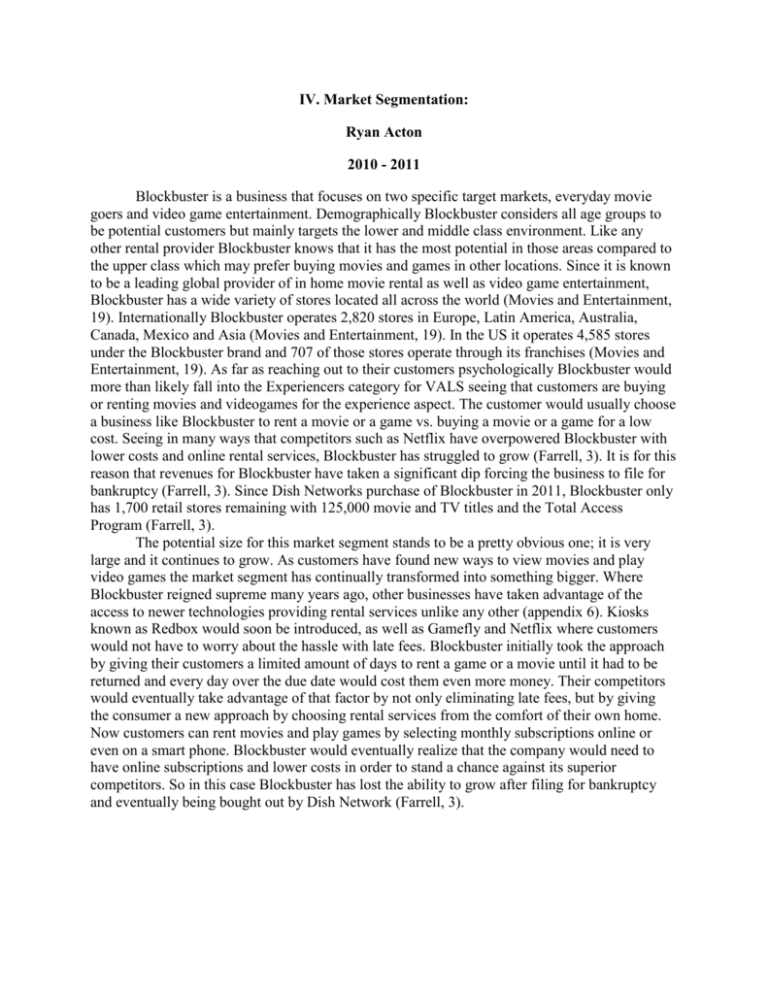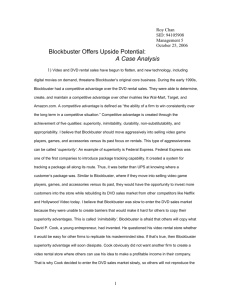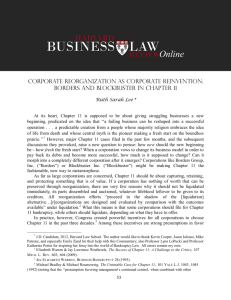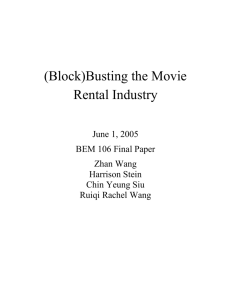Blockbuster Research doc
advertisement

IV. Market Segmentation: Ryan Acton 2010 - 2011 Blockbuster is a business that focuses on two specific target markets, everyday movie goers and video game entertainment. Demographically Blockbuster considers all age groups to be potential customers but mainly targets the lower and middle class environment. Like any other rental provider Blockbuster knows that it has the most potential in those areas compared to the upper class which may prefer buying movies and games in other locations. Since it is known to be a leading global provider of in home movie rental as well as video game entertainment, Blockbuster has a wide variety of stores located all across the world (Movies and Entertainment, 19). Internationally Blockbuster operates 2,820 stores in Europe, Latin America, Australia, Canada, Mexico and Asia (Movies and Entertainment, 19). In the US it operates 4,585 stores under the Blockbuster brand and 707 of those stores operate through its franchises (Movies and Entertainment, 19). As far as reaching out to their customers psychologically Blockbuster would more than likely fall into the Experiencers category for VALS seeing that customers are buying or renting movies and videogames for the experience aspect. The customer would usually choose a business like Blockbuster to rent a movie or a game vs. buying a movie or a game for a low cost. Seeing in many ways that competitors such as Netflix have overpowered Blockbuster with lower costs and online rental services, Blockbuster has struggled to grow (Farrell, 3). It is for this reason that revenues for Blockbuster have taken a significant dip forcing the business to file for bankruptcy (Farrell, 3). Since Dish Networks purchase of Blockbuster in 2011, Blockbuster only has 1,700 retail stores remaining with 125,000 movie and TV titles and the Total Access Program (Farrell, 3). The potential size for this market segment stands to be a pretty obvious one; it is very large and it continues to grow. As customers have found new ways to view movies and play video games the market segment has continually transformed into something bigger. Where Blockbuster reigned supreme many years ago, other businesses have taken advantage of the access to newer technologies providing rental services unlike any other (appendix 6). Kiosks known as Redbox would soon be introduced, as well as Gamefly and Netflix where customers would not have to worry about the hassle with late fees. Blockbuster initially took the approach by giving their customers a limited amount of days to rent a game or a movie until it had to be returned and every day over the due date would cost them even more money. Their competitors would eventually take advantage of that factor by not only eliminating late fees, but by giving the consumer a new approach by choosing rental services from the comfort of their own home. Now customers can rent movies and play games by selecting monthly subscriptions online or even on a smart phone. Blockbuster would eventually realize that the company would need to have online subscriptions and lower costs in order to stand a chance against its superior competitors. So in this case Blockbuster has lost the ability to grow after filing for bankruptcy and eventually being bought out by Dish Network (Farrell, 3). Revenues and Profitability Assets and Liabilities (Movies and Entertainment, 21) As you can see from this data alone, profits have been decreasing while debt has been increasing for Blockbuster which is not essentially a good thing for the business, so it is obvious why the business eventually filed for bankruptcy. In this case Blockbuster services are not in high demand at this point. The business is currently focusing on repositioning itself with Dish Network. V. Consumer Buying Behavior: Ryan Acton 2010 – 2011 From the customers perspective there are many ways to buy and rent movies or games. Since Blockbuster still has 1,700 retail locations the customer could go to the store and make transactions in person (Farrell, 3). However since the business has expanded to using online services the company offers a few different subscription methods. If the consumer chose to go in the store they could subscribe to the Total Access subscription which requires a low monthly fee allowing the consumer to use a pass with no rental fees or due dates. The pass allows the consumer to choose any amount of rentals given on their pass until you need to exchange a new one. If the consumer chooses to rent online Blockbuster Online offers a 2 week free trial where the customer gets to choose their movies online and receive them by mail, in which case the customer then ships the movies or exchanges them in store for more movies. If the consumer likes Blockbuster Online after the 2 week free trial is up, the consumer would have to pay a low monthly fee. This goes hand in hand for gamers as well who have the option of choosing a Game Pass subscription (blockbuster.com). So in this case the consumer needs to see the need for Blockbuster rental services. Is it worth it? Do I really need to have a rental subscription when I can just buy the game / movie? Or why buy a game / movie when I can return it when I’m done? After the consumer has given that much thought into buying services from blockbuster they do an information search. The consumer learns about the different subscriptions (Total Access, Game Pass, Blockbuster online), as well as finds other alternatives such as Netflix, Redbox, buying from other retail stores vs. renting. After doing the research the consumer decides to go with Blockbuster Online services (Example: could be Game Pass, or Total Access). It’s all a matter of whether the consumer likes their decision from that point forward and is either satisfied or dissatisfied with their purchase (appendix 9). The customer’s involvement really depends on how interested they are in Blockbusters services. If the customer wants to rent movies and likes the service they are getting, the more they will want to be involved in the process. On the other hand if the customer doesn’t see the need in renting movies or games, the less likely they will want to be involved in the process. The only major costs involved in rental services is that you are more than likely going to pay a monthly subscription with high expectations. If those expectations are not met then the consumer will regret their decision. If we looked at the benefits of renting movies or games it would mainly consist of not having to keep the movie or game when you are done with it. Really it would be more of a cost to use rental services because of having to pay monthly fees vs. just buying movies or games. It really all depends on what the consumer sees as a reasonable purchase decision. Works Cited Farrell, Market. “Ergen’s Blockbuster Victory: Is There a Plan Behind Dish Network’s Lates Purchase?” Multichannel News Vol. 32.Issue 15 (2011): 3-3. Business Source Complete. Web. 5 May 2011. “Global Movies & Entertainment.” Movies & Entertainment Industry (Mar. 2010): 1-40. Business Source Complete. Web. 5 May 2011. <http://web.ebscohost.com.proxy-tu.researchport.umd.edu/ehost/ pdfviewer/pdfviewer?sid=9b7e8922-aa30-4335-9df41ad4640a5bd3%40sessionmgr104&vid=20&hid=112>. Grewal, Dhruv, and Michael Levy. Marketing: Second Edition. New York: Paul Ducham, 2011. Print. Blockbuster.com











